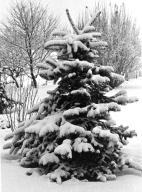Eric Praetzel Southern Ontario Gardening and Fruit Trees
Local Information
Seeds
Here are some good seed sources:
- Seeds of Diversity (Seed Exchange)
- Ontario Organic Seeds
- Cottage GardenerSeeds
- Veseys Seeds (and more)
Here are some good books:
- The End of Food - Thomas Pawlick
- Appropiate Technology Sourcebook
- http://www.Lehmans.com
- Rodales All-New Encyclopedia of Organic Gardening: The Indispensable Resource 2004
- USDA - The Commerical Storage of Fruits, Vegetables and Florist and Nursery Stocks
Here is a picture of my small yard. It's actually showing only 11 of my 14 fruit trees.

I am located in Southern Ontario Canada aprox. 100km west of Toronto. The
winters here can be very harsh. In 1994 we had 5 days of -30C weather
that nearly killed my one nectarine tree (ie only about 1" of wood above the
ground was left alive) and caused a fair bit of bark dammage on various
other trees.
Useful Links
- California Backyard Orchard
- http://ssfruit.cas.psu.edu - excellent site for Small-Scale Fruit production
- Natural Insect Control
Comments
Yea this page is a mess!!
As of summer 2009 I have come to the conclusion that I don't like dwarf trees. Semi-dwarf are nicer - just prune them to the size you want. The dwarf sour cherries give a small harvest; but the apples are ok (if you don't mind worms).
Yes you can space dwarf trees about 2 meters appart - but don't do it as they really should have light and air to deal with brown rot and other issues.
I dry some of my fruit and have a web page for information about drying fruit
Our Garden
PH Measurements
In May 2008 we picked up some rolls of PH tape (measures PH from 1 to 12 in steps of 1; $10 for
a double rool from our Chemistry Store at the local university) and start measuring things:
- Tap water 6 to 7, dehumidifier water 5!!, vinager 4.5, human spit 7
- Lemon tree (doing poorly) soil 7
- community garden plot #3 7
Fall 2008
Dec 12th - we are eating up the last of our rutabega, carrots will last a few more weeks
and the frozen kale / will last (one to two meals per week) all winter.
We shelled some of our corn and put it into a coffee grinder - it destroyed the plastic lid. I then
put the corn into a mortor and partially ground it and finished it in a coffee grinder and baked it
into corn bread. The black, white, red and blue kernels made a grey colored bread that was quite good.
Nov 30th - we dug up all of our leeks and 5.9kg of carrots (in danger of freezing in a raised bed). We still have kale in the garden (buried under snow) but the kids have been riding toboggans over it. We're still eating pears from the one tree, we have enough kale, in the freezer, to have kale soup twice weekly all winter.
Summer 2008
June 1: We had a nice sorrel soup and lots of rubarb. We turned the mustard garlic (invasive weed) into a nice pesto meal.
June 23: Flea beetles killed my kale, brussel sprouts, kohrabi and radishes - very quickly.
My attempt to grow lambs lettuce/mache failed again. I saw nothing come up
The spring had a hot blast but it has stayed cool and wet. As of early June the lettuce is coming in bag by bag. Beans are suffering and it looks like flea beetles. Potatoes are doing well as are tomatoes (even though I let my tomatoes go dry twice and shocked them by moving them out too soon. My fava beans are doing well - lots of blossoms. The "brazilian peas" from my friend on Vancouver island are growing very strongly. My crop of peas is growing well at the community garden in one plot - but all other plots of peas are not growing that well. "Volunteer" kale at home is growing better than all kale we started indoors! Carrots (due to flea beetles?) are doing poorly. We did not get much spinach.
Summer 2007
Pests
Sept 24 - Squirrels from HELL! A squirrel discovered that there are seeds within squash and in mere minutes nibbled at or thru most everything we had drying/hardening and then it started on what was left in the garden!
Cucumber bettles are a problem with squash as is squash vine borer (they've pretty well killed all plants and much of the fruit). Light green worms 1cm to 3cm long are eating leaves from my brussle sprouts and some small critters have been eating off carrot tops (rust fly?) as well as kale and other leafy greens.
My morning ritual involved picking raspberries, cherries and now involves squishing green worms on cabbage family plants.
Comments, Plantings
July 1 planted Pixwell Gooseberry after taking out a cedar tree.
90cm to 2.4m spread 1.2 to 3m
page green fruit becoming pink when ripe; few thorns!!! (ha!)
white flower and fruit on old wood in mid summer, likes rich well drained soils
Our garden tested low to very low for N, P, K and there is no time to put in manure as it's mostly
already planted (late April).
For the 2007 year I'm trying the following:
- Sorrel
- Covering the garden with plastic. This pre-warmed the soil and prevented frost from from setting in again during a cold snap in April. Plastic tubs are used to protect some plants.
- A variety of chard - Russian is being tested.
- More tomato varieties are being tested - Sweeties (OSC), heritage beefstake, "boars heart", a heritage plub from BC and some cherry tomatoes from U of Guelph.
- Pre-spouts of legumes. Peas and beans will be sprouted in a tray for 5 days before planting. This worked well in summer 2006 with a clay soil in our community garden and will help deal with slow germination in cold soils.
- Mache or Corn Salad or Lambs Lettuce. I'm trying a spring crop as well as fall and winter crops.
- Ton 'o' peas. We've put in around 150 heritage pod peas and even more "snap" peas. Most of those will be followed with a crop of bush beans while the rest are interplanted with carrots.
- Four brussel sprout plants were started 5 weeks before last frost. The rest are started 3 weeks before last frost (May 24).
Sept 2006, My mid-summer planting (kohlrabi, winter radishes) has been going poorly. They are currently 6 weeks old and very small in size. The apple crop this year is poor - birds are decimating the Matsu apples and they're scabbed and small as well. The red delicious tree is loaded and there are hopes for a crop. The red ever-bearing raspberries are doing well and coming in strong in mid september. The Ajou pears are all picked and eaten now and the Bartlett ones will be getting picked soon. Both pear trees were heavily loaded this year! Plumbs are still coming in. I can pick a few medium wooden baskets at once. Mold on the fruit is a massive problem this year as are squirrels. It's been over 4 years since I used a lime sulphur spray - this winter I'll trim the tree and spray it in spring.
May 29, 2006. After reading Square Foot Gardening and BioIntensive Gardening (www.GrowBioIntensive.org) I double dug one of our gardens. Ie dig down 2 shovels and we loosened the lower soil by mixing in leaves. The results this spring were amazing. The garden was much higher and soaking up water like a sponge - instead of running off like it usually does.
After years growing things in our clay soil we dug up the garden, fall 2004) and replaced the soil with tripple-mix and doubled the size of the garden.
Community Garden - 2006
In 2006 we got involved with a community garden. The soil was a heavy clay that crusted over quickly after a rain. The roto-tilling was useless and so we turned it by hand, one shovel deep. Trying to dig deeper was impossible - too rocky! Also the managers started very late; we were already havesting peas and radishes at home!
We planted peas and out of about 100 seeds only 3 came up. We then sprouted bush beans at home and planted aprox 100 seeds in a 4 foot square patch. Over 90% of them came up and in late July we picked 5lb of beans on one day alone - several more pounds were ready two days later!
Kale and Swiss Chard also does well. The established red currents, mint and Jerusalm artichoke are doing well on their own. Tomato plants (primarily non-watery varieties for drying) are low and doing well.
2006 started out warming early and was quite dry - long periods between rain. July has been very wet with hot, but not exceedingly hot or humid weather.
Early Planting
As soon as you can turn the soil there are many things that you can plant. We plant the following (typically at the end of March):
- Tomatoes (hundreds/millions and beefstake varieties) are planted indoors
- Carrots (seeded between peas)
- Kale & Swiss Chard
- Lettuce (replaced by relocated chard & kale when they're done producing)
- Peas (sugar pod and Alaska)
- Radishes (seeded where tomato plants will be)
- Spinach
When things warm up and the danger of frost is over then the tomatoes go outside and we plant zuccini, beans (sprout the seeds inside to give them a head start!) and other vegetables.
Mid-Season Planting
Read Square Food Gardening for ideas!
There isn't much to plant in our climate in the mid season. But this is what we do now:
- transplant chard and kale plants as they tolerate being dug up by shovel and moved.
- in late July, every 2 weeks, plant winter radish (China Rose) in freed up, shaded spaces, around tomato.
- In late August, every week, start planting radishes for the fall
- move small cabbage, kohlrabi into available spaces
- start planting cool weather things for fall - lettuce
My Views and Feelings on Fruit Trees
If asked about these sorts of trees I'd say:- Frankly, the trees tend to be low maintance and, in this area, the crops can be bountifull or, more usually, small or nothing.
- Drawf trees require less pruning than hedges of cedar, spruce or other full sized trees.
- Apple trees fruit heavily but are subject to worms. If you're not going to spray; you're not going to get very much edible fruit.
- My apricot has done very well for me over the years and I love the fruit.
- My plums have done well at times; but some years bring a massive moldy crop.
- Some years I get a good pear crop.
- I've had no luck with nectarines although some success with peaches. My sweet cherry tree grew like a weed and gave me no fruit. My sour cherries don't grow but fruit like mad.
- Birds, rabbits and chipmonks are the spawn of the devil. They'll pick your fruit before you do. Chipmonks chew the branches off of the trees to get the fruit to the ground. Rabbits will strip the bark off of various trees in the winter. Aphids, worms and other small critters will make life difficult at times.
- Some years I've had massive aphid problems with my plums; pear-slugs on my pears, sweet cherries. I've rarely had worm problems [spruce bud worm and small green worms striping my currents] on the fruit trees.
- Black knot is a problem on plums as is peach leaf curl on the peaches and nectarines. The
only relief is a lime sulphur spray done before the leaves open.
Here is a bad case of peach leaf curl from June 2002. I was unable to spray with
lime sulphur because leaves started to come out in March after a very hot spell!
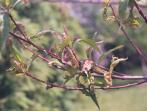
Hold Vines and Fruit Upright
If you are growing vines or canes [raspberries, currents, blackberries] against your home you'll find that the brick quickly rubs thru and kills the branches. You will need to tie the branches to your home so that they can't rub. I simply built a wooden (cedar, not that poison, pressure treated, wood) rack for tying the branches.
Spraying
The trees only bloom for a short period of time (ie a few days). Spraying of herbicidal oils should be done before the leaves open. You don't need to use special oils. A solution of 5% veg. oil with a bit of soap (to make the water & oil mix) does an excellent job of killing bark harbouring insects, aphids and many other pests.In the summer you can spray with a light soap solution (ie 1 Tbl. spoon of soap per 2L or 2 quarts of water). Soap is a contact poison and will kill only on contact. It will also kill scale, catipillars, pear slugs and spruce bud worms.
Here is some information on Pear Slugs. They love to go after the leaves of pear and cherry trees.
Pests
Rabbits
I sprayed the tree trunks with 3oz (90 ml) of Lousiana hot sauce diluted with water [for my sprayer] in desperation in the winter of 2001. Due to deep snow the rabbits were chewing off branches and bark well above the plastic strips I had protecting the stems.You must protect your fruit trees from these animals; in particular apple, cherry and pear. They will also eat 1-year old brances from apricots and other trees but generally avoid the older branches / bark.
Pear Slugs - Aphids
I have had problems with aphids, pear slugs as well as catipilars. The aphids and pear slugs are easily killed with a weak soap solution (ie 1 tbl spoon of Ivory soap in 1.5L of water). It also works on catipilars but not as well. Soap is a contact poison for many insects and it leaves no residue. Do NOT spray the trees in hot weather. Pick a cool time and rinse the trees after. If you do not rise the trees in warm weather the leaves _may_ yellow and drop off.Pear slugs are a translucent to dark slug that eats the leaves of trees. It only went after my pear, sweet cherry and pear trees; none of the others.
A solution of vegatable oil with a bit of soap makes an insecticidal soap spray. I believe that it was about 5% oil by volume. Spray that on the trees before the leaves open and it kills insects that harbour in the bark. It can also be sprayed during the summer; but _AVOID_ hot weather.
Aphids seem to primarily go after my plum trees or apple trees and they prefer new leaves over all else.
Lime sulphur sprays must be put on before the leaves open. This solution is necessary for peach trees to prevent/control peach leaf curl (a fungus that stays on the bark).
Spraying Times
- Lime-sulphur - Spray peach and plum trees to control peach leaf curl and black knot on plums [spread via spores].
- Diazinon - Avoid this and other pesticides as much as possible. Pesticides are a
severe health hazard causing both mental and physical retardation in children.
Spray this after the flower pedals have dropped or else
you will kill insects which pollinate the trees. I used this to control small
green worms on my bushes [they eat the leaves] but found that a soap solution will
also kill them. In the summer of 2001 I was finally desperate
enough to spray my apple trees in a desperate attempt to see if I can get
fruit that is somewhat free of worms. Most of my apricots and pears are worm free.
Spraying should be done in the morning before insects are active. These sort of chemicals work by putting a layer, or get absorbed into the skin, of poison on the fruit. Many of these chemicals are hormone based and have nasty effects on people. Recent research is looking at learning difficulties, mental developmental problems. Various chemicals are also known to react together for horrific effect.Don't use chemicals unless you desperately need to!. Keep in mind that most insecticides kill not only pests benefical insects and earth worms but harm or kill every other living animal that gets in contact with them. The chemicals can readily be absorbed into softer fruit such as apricots and peaches and take weeks (months?) to reduce to "safe" levels. Always read the safety literature from the labels and then err massively on the side of caution.
Fungal Problems
- Brown Rot attacks Japanese plums and hybrids. It is a fungal disease that rots fruit. Damp weather and lack of air circulation make this worse. Infected fruit should be removed and destroyed. Prune the tree to allow for air circulation.
Yearly Comments
- Sept. 2006 - A very strange year. Like last year an early blast of heat bolted
the lettuce, spinach, radishes. But late July / August was wet and so the grass
never browned! Bush beans grew quite well and we had an exceptional crop of
pears, plums and tomatoes. This year the squirrels did not demolish my fruit tree
crop!!! I also netted the pear tree as much as possible and picked the fruit
early as they rippen indoors quite well.
I'm waiting to see how my fall crop of winter and summer radishes and kohlrabi do. - 2005 - An early heat wave bolted the lettuce, spinach and radishes.
- Sept. 2002 - Good tomato crop, only fruit tree with fruit is one plum (due to early warm spell in March - then heavy frost for another month). Chipmonks stiped the grapes while they were still green. I had a small fig crop.
- Sept. 2001 - Chipmonks strip my plum and pear trees. I picked the apricots early so that they didn't get the whole crop. Apples are doing very well and fallen fruit is quite eatable. I sprayed with diazinon once after blossom drop and instead of being worm infested the fruit is edible.
- Summer 2001 - DRY For over 6 weeks we have not had any rain. Leaves are curling and apricots were very small. With watering the fruit increased in size and the trees are doing better.
- Winter 2001 - Rabbit hell. One rabbit has done severe dammage to my apple, cherry, apricot and other yearlings. It's eaten massive amounts of bark as well as entire small branches!
- 2000 - What a year! It has been wet and cool with some hot days. The nectarines were rotting on the tree, there were few apricots, plums or pears. The peach crop was good but peach leaf curl was quite bad due to the weather.
Picking Fruit
At times I have picked the fruit before it was ripe and put the fruit into the refrigerator (and left it there 3 to 4 weeks!!!). The plums did soften but the flesh clung to the stone. Meanwhile the fruit that I left on the tree was just as ripe and seperately from the stone perfectly.
Fruit Tree Information
Here is a list of my trees and how they have fared:- Apple:
Dwarf tree height: 2 to 2.5m
Semi-dwarf height: 2.5 to 3m
I rarely get fruit from my bug-free apple trees. I've had many problems with aphids on new shoots of these trees (when young). A weak soap solution kills them on contact. After 4 years the ladybug population increased (I now see some!) and the aphid problem is non-existant.- Russet
Planted July 1992. This tree grows quickly in all directions and has many small fruit that are riddled with worms. - Matsu:
Dug out Sept 2014. The tree had curling leaves (there was an infected tree about 2m away) and about 1/2 of the tree was cut away to bring the infection under control but then mold broke out all the way down the trunk and there were white grubs in the outer layer of wood. Info about pests in the trunk include: http://nysipm.cornell.edu/factsheets/treefruit/pests/ab/ab.asp
Planted July 1992. These trees grow more than the Red Delicous but less than the Russet and it has had small crops of large fruit that are worm filled. They do have beautiful red flowers though. The bark also suffers in Canadian winters. It is not uncommon to have long cracks form in the bark or for the bark to blister off.
The one Matsu with heavily dammaged bark was pulled out April, 1999. - Red Delicous:
I have recieved some large pieces of fruit from this tree but, like all apples, they are wormy. The tree itself does not grow very much and it has suffered from rabbits eating the bark in the winters of 1999 and 2001.
- Russet
- Peach like:
Standard tree [peach, nectarine, apricot] height: 4m
My peach trees fruit heavily some years. They primarily grow up but also out. Yearly pruning is a must and there is always plenty of wood growth. Worms in the fruit is one problem and spraying is helpfull. Often the unripe fruit gets eaten when the birds discover the tree. They will strip it of fruit in a day. Peach trees don't like in the cold winters here. Bark and limb death is not uncommon.- Nectarine (Nectared #4):
Planted June 1, 1993. The trunk was killed in the 1994 winter by sustained -30C temperatures. The roots (and upto 2cm above the ground) was still alive and a single shoot came out. By 1997 this tree regrew fully and it blooms well although it has yet to bear any fruit. The fruit often looks bad and then shrivels and/or perhaps it gets eaten by chipmonks.
May 1999: A lime-sulphur spray has greately reduced the peach leaf curl problem that has plagued this tree for several years.
July 2000: There was a good crop by with the wet year they all turned black, shriveled and dropped. - Apricot (Veecot):
Planted June 1, 1993. This tree grows out as well as up and blossoms like you would not believe. It has withstood some harsh winters and has fruited heavily since 1996. Worms in the fruit are a big problem. Also the chipmonks strip the tree of all fruit as they start to blush red. The fruit is usually free of worms.
- 1998: 6 quarts of fruit picked early to beat the chipmonks! The fruit had scars but only 10% had worms. I cut and dehydrated the 6 quarts to get 290g of dry fruit.
- 1999: 40lb of fruit - picked early with bird problems on July 21
- 2000: 10 pieces of fruit.
- 2001: Tons of fruit but it is small due to high heat and insufficient water.
- Apricot (type ?):
Planted April, 1999 - Harcrest Peach:
Planted May 21, 1994. This tree has suffered due to the cold weather and peach leaf curl. I ment to spray it in the spring of 1998 but the leaves blossomed so early that I could not apply the lime sulphur. It was setback greatly due to the loss of all leaves. By early July it started to regrow a good number of leaves. This tree has blossomed but never had more than 2 or 3 fruit and none made it to maturity.
May 1999: The lime-sulphur spray did a good job of reducing peach leaf curl.
Fruit on this tree has never fully matured.- 1999: crop was aprox 5 lb and destroyed by birds in a single day (July 21)
- 2000: 16 quarts of fruit - picked early because the birds were picking them. They ripened indoors quite wwell in 4 days.
- Nectarine (Nectared #4):
- Pear:
Dwarf tree height: 3m
Semi-dwarf height: 8m
I had severe problems with pear slugs for the first 4 years with these trees. A weak soap solution kills them on contact.
In 1998 I had 6 quarts of fruit from both trees.- Bartlet:
Planted July 1992. It has been growing slowly with a small crop every year. Unfortunately the chipmonks eat all of the fruit off of the tree (the solution is to net the tree with a fishing net). The fruit tastes great. Flowers are a nice white color and the tree flowers well. There does not seem to be a problem with bugs in the fruit; simply the amount of flowers that get fertilized perhaps?
1998: The leaves seem to have a growth on them and is reddish on top with the growth on the bottom side of the leaf. 1999: Sept. 14th. I have an excellent crop. The tree is literally falling over with fruit. - Dwarf Anjoy:
Planted June 1993. This tree has been exactly like the Bartlet pear. 1998: The leaves seem to have a growth on them and is reddish on top with the growth on the bottom side of the leaf. This is a spore (??) that alternates between cedar trees and pears. It is a jelly like growth on the cedar trees and the spores blow in the air and infect the pears the next year. Those growths then re-infect the cedar trees.
1999: I've had an excellent crop and the crop is very late (think when the leaves drop!) so the squirrels just leave the tree alone. Eating the fruit can then be spread over weeks to months.
- Bartlet:
- Cherry:
Sweet Cherries-
height: 6 to 7.5m when unpruned
You need a 2nd tree to fertilize a sweet cherry.-
height: 3 to 5m
Sour cherries are self-fertile and can bear fruit like you would not believe.Cherry Trees of mine:
- Sweet:
Planted July 1992. This tree growes like a weed; shooting up up and ever up. This is the first year (out of 5) that it has more than a handfull of fruit. The fruit is good and sweet but the tree suffers heavily in the winters and suffers extensive bark dammage with sap running down the trunk. What fruit there is is usually wormy. White fungus started growing on the bark in summer 1998
I cut this tree down in Sept. 1998. - Sour:
Planted July 1992. This tree grows slowly and fruits heavily year after year. I have had problems with mold in wet summers. The fruit is not very tart but quite nice. The only way to stop the birds from eating the fruit is to net the tree. Fruit is typically ready July 1.
This tree died May, 1999. I was unable to determine any reason for death as the tree looked healthy. - Sour (English) North Stay:
Planted April, 1999: This tree is stunning. It grows fairly quickly and has topped 3m tall within 8 years. I can easily get 5lb of cherries for a week running in season. The issue is getting up high enough (safely) to pick the massive harvests. - Sour (same as the '92 tree):
Planted May, 1999 - it has grown very very very slowly - much like the older tree that was the same type (2 meters).
- Sweet:
- Plum:
- Stanley
Planted July 1992. The plum trees grow up more than out and always flower and fruit heavily. There are no problems with bark dammage in the winter. There are no problems with worms in the fruit (I don't spray) and there is always plenty of fruit. There is a fairly large amount of fallen fruit every year. In the past year the chipmonks have striped the trees of all fruit :<Note: The mold problem that I have had may not be due to mold but to a growth on the fruit.
On wet summers the fruit often goes moldy and on dry ones I go nuts trying to dehydrate and freeze it all. This is my favorite type of fruit tree - ie resistant to pests and fruits heavily year after year. However, aphids do seem to like these trees; but they are easy enough to kill with a weak soap-water solution.
The fruit clings to the stone with this variety; but it is an excellent fruit to dehydrate. The flesh is yellowish, firm and tart.
- Bluefre
Planted July 1992. This tree has fruited heavily after 1 year and continues to do so!
The flesh comes off of the stone very easily but the fruit does not dehydrate well. The fruit tends to be very sweet with redish flesh. - Stanley
Planted April, 1999 Black knot (a growth girdling a branch) has been a bit problem some years.- Pre July 1999 - removed aprox 5 growths from both trees
- July 27, 1999 - removed 5 growths from 2 trees
- summer 2000 - removed 2 growths from 2 trees
- June 2001 - removed 4 growths from 2 trees
- Stanley
- Rubber Plants:
-
They are durable and grow in dim to bright light. Let the soil dry out between waterings
- Lemon:
June 2007 - The lemon tree is dying. It's heavily root-bound. I will take it out of the pot and, unlike last time, prune both the roots and top back. In hindsight this tree has grown much larger than it was and I'm not willing to give it a bigger pot. Leaves yellow, curl and drop. I've been giving it fertilizer and that stimulates leaf and wood growth; which quickly dies.
Jan 2007 - Over the past few years the fruit always starts to rippen in February (picking can be delayed months) and leaves tend to yellow and fall in the winter. Newleaves grow this time of year as well. The tree is starting to blossom in early February.
Nov 2005 - The lemon tree has been growing well indoors. I've not taken it outside in over a year now and it's fruiting well. It's in a bay window and really only gets sun in the afternoon but it does well enough. Manually pollinating it doesn't seem to be necessary as I mostly stoped that and get lots of fruit. Tap water is building up minerals in the soil so I'd suggest rain water. I only fertilize every few months - if that (with Miracle Gro). My father has been growing some on the west coast and they grow up and up and up. Only when they've had their top cut off do they grow side branches. This happens in good lighting!
July 2001 - I've started to grow a lemon tree. It is a variety from South America and the fruit are orange in color. It has sprouted from the seed and was 2cm tall on July 18, 2001. I plan to move this seedling outside as soon as it gets used to the summer sun. I have been warned that moving this type of tree from the indoors to full sunlight shocks full grown trees enough to make them drop some of their leaves.September 2001 - I put the small tree outside in the summer and the leaves were eaten off by something. Well, it's time to plant another seed!
My friend has 20+ pieces of fruit on his 4 year old tree. October 2001 - I moved the tree inside after heavy rains and the soil was quite saturated with water. Within 2 weeks the nearly every leaf yellowed and droped. It took 6 months for the tree to recover.These trees like direct light and you should let the soil dry out between watering. They flower and fruit year round. You'll have to pollinate the flowers with a small paint brush. Seeds take 3 to 6 weeks to germinate and putting them in a refigerator for a few days is supposed to help them germinate faster.
Lemon (citrus) trees are very sensitive to being overwatered. My tree dropped almost all of its leaves because the soil was soaked when I took it inside in the fall. Once the soil dried out it quickly started to grow leaves again. They do fruit year round and you'll have to pollinate them yourself with a small painbrush.A common problem is a yellowing (chlorosis) of the leaves. Chelated Iron is used to solve this problem. You'll need something with a fair bit of iron - not the 0.1% or 0.2% found in fertilizers.
This is a 2 year old Lemon Tree that my friend gave me. The first picture is fall 2001 and the 2nd is June 2002 with two several month old trees grown from seed. The 3rd picture was taken in late August 2002 and shows some growth as well as a yellowing of the leaves due to a lack of iron in the soil.
Lemon Tree


Here is the 5 year old tree before I moved it to my house. Shortly after this, when it was moved outside, the tree was dropping leaves like rain! It did not grow very well for a month and then I removed the tree from the pot, cleaned up and cut away the pot-bound root ball and put the tree into a slightly bigger pot. The 2nd picture shows the tree just before I repotted it.
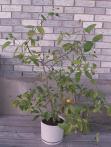
- Grapefruit Tree:
-
These trees grow quite tall and have very interesting leaves. Friends have been unable to get theirs
to fruit. I'm told that it takes a lot of fertilizer to get fruit to set.
- Mango Tree:
-
I would not recommend trying to grow one of these as they do grow > 7m tall!
Baby Mango Tree
Winter 2001 - My wife is growing a mango tree. The leaves are exceptionally long; making me believe that the tree is not getting enough light. I will introduce this tree to full sunlight slowly and leave it outside during the summer.
- Pineapple Plant:
-
We are growing a pineapple tree from the top of a pineapple in 2002. Just cut the top a bit
below where the flesh starts; scoop out the flesh and let it dry for a few days and
then pop it into soil.
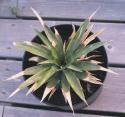 June 2007 - It's fruiting! We've not been putting it outside and all and not
fertilizing it; but I did give it some fertilizer recently.
June 2007 - It's fruiting! We've not been putting it outside and all and not
fertilizing it; but I did give it some fertilizer recently.
- Fig:
-
Fig trees are easily grown in this region. They are quite winter hardy and can be stored in
a protected space, that doesn't fall below freezing, such as a garage or basement during
the winter. In the winter should be watered
infrequently and then introduced to full sunlight slowly in the spring.
Growth generally starts from the green tip at the end of branches. The tip will open and 2 leaves will come out. Also, branches and fruit will appear on the side of the branch near such leaves. Branches will also start to grow along the trunk. Just rub off the growth that you want to prevent.
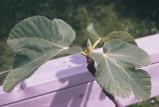

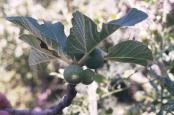
- Blackberries from hell:
A friend in Toronto gave me a blackberry cutting that had been potted. I planted it late in the fall and it stayed green all winter. It looks and grows like the thick dense blackberries on the west coast (Vancouver and the island). ie plenty of large stiff thorns. But the fruit from these plants is very tasty. This plant does grow very quickly!
In June 2002 we ripped out this weed. It was not blossoming and growing like crazy. It had spread over 1m in either direction and was sending runners everywhere. I fully expect that the remaining roots will tenaciously cling to life and grow shoots. - Wild Strawberries:
Many of the trees planted on my property came from a farm and along with them came wild strawberries. They grow around my fruit trees, here and there, and blossom and fruit each year. I cut the grass as high as possible and that way the continue to grow and I get some berries to pick.
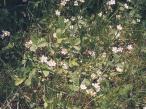
- Wild Black Raspberries:
Planted summer 1999
Fruiting heavily in summer 2001. Some of the stalks grow straight and tall and never fruit. The fruiting stalks are the small gnarled ones. NOTE: I've never seen worms on black raspberries but always see them on red raspberries.
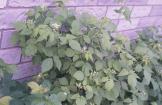
- Red currant:
Planted June 1997
Fruit is ripe early to mid July. It is plentifull and birds don't seem to eat the fruit and I have had some pest problems.
Many small green worms were defoliating all of my current bushes and they were doing it very quickly in the summer of 1999. Soap spray did not kill them and manually trying to kill them was not working. A malathion spray quickly killed them all. - wild Red currant:
Planted June 1999 from clippings taking on a hiking trail (using rooting compound). - Josten berry:
Planted July 1999
Fruiting 2000, 2001 but the fruit actually look exactly like currents
This is a cross between a current bush and a goose berry and the fruit are supposed to look like a cross between the two. - Grapes:
All of these grapes have a thick skined fruit with seeds in the core. The
meat of the fruit is fairly stiff or jelly-like and quite flavourfull. It
makes an excellent jam in all cases. The grapes grow very strongly if they get
water. Here is a new shoot tossing out more leaves and fruit.
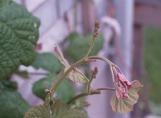
- Fredonia:
This vine grows on my fence and is in dry soil. It fruits lightly. I believe that the fruit was a light yellowish color. - Agawam:
This vine grows another another fence in somewhat dry soil and fruits lightly. The fruit is a light red. - Van Buren:
This baby grows on my porch and is by the main water downspout. It fruits heavily and grows heavily. My only beef is that I must continually chop away at it to get air/light into the fruit. Spiders also seem to like nesting in the bunchs of fruit. The fruit from this vine is dark purple.
- Fredonia:
Growing Plants
Currents
-
To grow another current bush cut off a 35cm (15") straight shoot. ie less than 1 year old. Rub off all buds and branches except for the 4 or 5 buds closest to the tip. Dip the end in rooting compound and plant it 20cm (8") deep in soil.Plant other shoots at least 15cm (6") appart.
This is best done in the mid fall. It will take the shoot about 6 weeks to grow some roots. By late fall you can replant it. You should plant it 5cm deeper and shorten any branches to 1/2 size.
I've successfully done this in mid summer!
An easier way is simply to wait a few years and your current bush will be surrounded with small plants growing from fallen seeds.
You WILL have problems with small geen worms eating the leaves. You can kill them
by spraying a soapy water solution. Diazinon kills these critters really quickly
but I avoid these sorts of chemicals wherever possible.
Here is a picture of a branch of one of my bushes - with fruit (June 10, 2002).
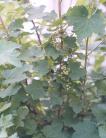
Garlic
-
Just plant garlic cloves 2 to 5 cm deep in the fall [cool weather - ie October] about 5", 12cm appart, 12", 25 cm
between rows. They like well drained soil with plenty of compost or manure. I tend
to plant mine closer than that.
You can also plant them in the spring time, but they will not grow as large. Some even end up like onions!
Here is a picture of some of my garlic. The plants on the right are grown from cloves and they are fairly large. The smaller plants on the left are grown from the bulbils - the small bulbs in the curly trail of a grown plant.
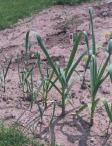
Tomatoes
-
"Boars Heart"
Note how very dry this tomato is - flesh but not much juice - often not many seeds.
Cut off the lower 2 or 3 layers of branches and bury them under ground when planting. This will give you a plant that takes a while to start growing but then it grows like mad. Roots grow to replace the broken off branches and the amount of resulting fruit is amazing.

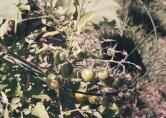
Hens and Chicks
-
Here is a really really big variation of Hens and Chicks. They were growing well on
Vancouver Island but I have put them out in a cold Ontario winter yet. The flower has
wonderful pastel flowers.


Misc. Plants
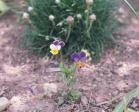
Sadly, you'll note that some of these flowers and leaves have been eaten off by ducks. They just love the tender young growth.



Gardens
-
Here is a view of our garden from June of 2002. It's a small garden and you can see the
tomato and garlic plants as well as beans, watermellon (heritage), peas, basil, cohlrabi,
carrots and other
plants on their way. It seems that every year we make the garden bigger. The tomatoe
plantes do well at the top and the garlic doesn't care. Usually we put a row of carrots
at both ends. When the beans and peas die off the lower plants such as the carrots get
lots of light.
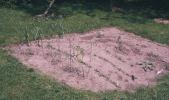
June 2007
Here are pictures of our two plots at the community garden. One was just planted with
the three sisters - corn, beans, squash:
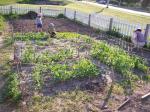
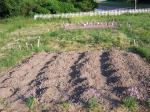
Back to my home page
